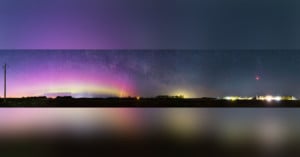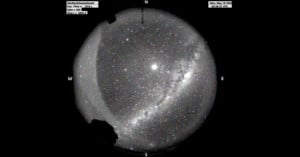
Photographer Shoots Timelapse of Total Lunar Eclipse on 35mm Film
A photographer used a 35mm analog camera attached to an enormous telescope to create a stunning timelapse of the lunar eclipse using 180 photos and five rolls of film.

A photographer used a 35mm analog camera attached to an enormous telescope to create a stunning timelapse of the lunar eclipse using 180 photos and five rolls of film.

Aloha and welcome. You must be here because like most people, you waited until the last minute to do something. Or maybe you are just genuinely curious and had no idea there is a total lunar eclipse coming up. Whatever it is, welcome, and thanks for being here.

An astrophysics student captured a unique conclusion to his time in college thanks to a total lunar eclipse that occurred on the day of his graduation.

Photographer Justin Anderson shot a trio of gorgeous celestial elements together. During the total lunar eclipse, he was able to capture the Blood Moon, aurora, and the Milky Way galaxy together in one stunning panorama.

A total lunar eclipse wowed viewers around the world this week and in one timelapse video, it can be seen dramatically cutting the light of the night sky to such a degree that the Milky Way suddenly bursts into view.

On Monday, large portions of the planet were treated to a total lunar eclipse. And while there were many excellent opportunities to photograph it from Earth, one astronaut shared her photos that were taken from space.

The longest partial lunar eclipse in 580 years occurred this week, and photographers around the world did their best to capture the once-in-a-lifetime event on camera. Photographer Andrew McCarthy went the extra mile by staying up until 4am and capturing thousands of photos to create an incredible composite of the eclipse.

Tonight, a lunar eclipse that coincides with the Beaver Moon will result in 97% coverage and will last around 3.5 hours, making it the longest-lasting in 580 years.

G’day from Australia, my name is Jason De Freitas (@jase.film on Instagram), and I’m a photographer mostly known for my analog astrophotography. In this article, I’ll describe the process and decisions I went through to take this lunar eclipse multi-exposure sequence on medium format film.

You're about to learn everything you need to photograph a lunar eclipse, including the upcoming total lunar eclipse on May 26, 2021. Everything!

Photographer Jason Weingart shot this beautiful composite photo of the super blood wolf moon total lunar eclipse on January 20th and 21st. The image features six stages of the moon that night as it rose from the horizon and became totally eclipsed.

I normally love to plan my photos and I would have liked to plan a cool shot with yesterday’s moon eclipse. However, when I planned my current trip to Kyrgyzstan, I didn’t realize I would be there with the lunar eclipse of 2018 (bad planning, I know).

Back on January 31st, photographer William Briscoe set up his cameras near Fairbanks, Alaska, and shot this awe-inspiring 360-degree interactive video of a lunar eclipse in the sky above the dancing green glow of the Northern Lights.

The photo above is a perfect example of when preparation and luck meet, shake hands, and press down your shutter in unison. Captured by wildlife photographer Will Burrard-Lucas, the photo shows a lion cub in the foreground with last September's supermoon eclipse in the background.

Most people use their smartphones as their go-to snapshot camera these days, and the impressive image quality of the latest models is great for recording everyday memories. The small sensor and lens do have their limitations, though, and quite a few people found that out last night when they pulled out their smartphones to photograph the supermoon lunar eclipse.

Renowned French astrophotographer Thierry Legault captured one of the most remarkable images of the supermoon lunar eclipse yesterday. He managed to shoot the world's first photo of the International Space Station passing in front of the moon during the eclipse.

People around the world were treated to a supermoon lunar eclipse last night and early this morning. It's a sight that won't appear again for another 18 years (the next one is in 2033). Photographers around the world brought their cameras out to give the sight their best shot, and the results are spectacular. Here's a rundown of some of the most beautiful photos and videos created.

This article is about how this time slice shot of a lunar eclipse was made. Its focus is mainly on the planning that went into it, even before the first shutter click. Hopefully by sharing what I did, I can prepare you for creating your own lunar eclipse photo.

If you lived in Europe or Africa -- or if you're in the US and the thought of getting up between 2 and 5 in the morning repelled you -- you probably missed this week's total lunar eclipse and 'blood moon.' But have no fear, because Griffith Observatory in LA captured a close-up (if a bit shaky) time-lapse of the entire rust-colored event for you.

In June of 2011, astrophotographer Jean-Luc Dauvergne travelled all the way to Tajikistan to capture the total lunar eclipse on June 15th in the best conditions possible. Lasting almost two hours, he captured the eclipse from start to finish in a captivating minute-long time-lapse with one heck of a crescendo.

For those of you who missed the blood moon this past April, have no fear, Mother Nature is giving you a second chance. On Wednesday, October 8th, the next blood moon will reflect bright in the sky.

The day after the last lunar eclipse we shared a time-lapse with you to help ease the pain if you hadn't had a chance to capture the first of this tetrad of eclipses yourself. The time-lapse was put together by NASA and, while it was better than nothing, it left something to be desired.
Fortunately, photographer Andrew Walker of 599 Productions is here to show NASA how it's done so they can maybe put something better together next time.

Over the past few years, I’ve become overly obsessed with photographing the night sky, so when I saw that we were going to be able to see the lunar eclipse on April 15, I knew I had to shoot it. I had been planning this shot for about two weeks before Tuesday morning.

This year, I was ready. I had gathered the necessary equipment, made sure I scheduled in time for an afternoon nap and did my research so I would be ready for this whole 'blood moon' thingy. Then: disaster.
If you were in the Jackson, MS area yesterday you'll know that the entire day (and in fact the night before) was spent being battered by both a fierce thunderstorm and constant updates from the National Weather Service letting you know that the flash flood warning had been extended... again.

Update on 12/16/21: This video has been removed by its creator.
On April 15th, a rather rare astronomical event is taking place: the "blood moon." While technically nothing more than a lunar eclipse, this particular event will the first of four lunar eclipses to happen over the course of the next two years.

Photographer Elias Politis created this beautiful image showing the June 15 lunar eclipse over the Acropolis in Athens, Greece by shooting a time-lapse video and then combining the stills into a single frame.

A couple days ago Flickr published a blog post featuring a handful of member photographs of the December 2010 lunar eclipse. The first image in the post was "The 2010 Winter Solstice Lunar Eclipse over Jersey City, NJ" (shown above) by photographer Steve Kelly.

Now here's a novel way to shoot the moon: stack five separate Canon 2x extenders to boost the focal length of your 800mm lens. Supposedly (and surprisingly) this rig actually captured a decent photograph of the moon.
This was done by the folks over at BorrowLenses, who also did the crazy filter stacking thing we featured recently. When you have as much gear as they do at your disposal, you have a wider range of ways to have fun with gear experiments.

Last night there was a total lunar eclipse that just so happened to …